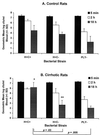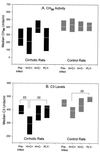Pneumolysin-induced complement depletion during experimental pneumococcal bacteremia
- PMID: 11349015
- PMCID: PMC98338
- DOI: 10.1128/IAI.69.6.3569-3575.2001
Pneumolysin-induced complement depletion during experimental pneumococcal bacteremia
Abstract
To quantify complement depletion by pneumolysin during Streptococcus pneumoniae bacteremia, cirrhotic and control rats were infected intravenously with one of three isogenic mutant strains of S. pneumoniae expressing different forms of pneumolysin. Outcome measures included clearance of the organisms from the bloodstream, alterations in 50% serum hemolytic complement (CH(50)) activity and complement C3 levels during infection, and serum opsonic capacity at 18 h postinfection. Cirrhotic rats had significantly lower CH(50) and C3 levels than control rats, both before and after infection. However, initial complement levels did not predict bacterial load after 18 h of infection. Changes in CH(50) and C3 levels over the 18-h period correlated with numbers of H+C+ but not H+C- or PLY- organisms in the bloodstream at 18 h postinfection. The sera of cirrhotic rats infected with the H+C+ strain had significantly decreased levels of C3 and showed significantly lower opsonizing activity for S. pneumoniae than sera from H+C+-infected control rats. These studies suggest that under limiting concentrations of complement, the expression of pneumolysin by pneumococci has a significant, negative effect on serum complement levels and reduces serum opsonic activity.
Figures




References
-
- Adams H G, Jordan C. Infections in the alcoholic. Med Clin N Am. 1984;68:179–200. - PubMed
-
- Benton K A, Paton J C, Briles D E. The hemolytic and complement-activating properties of pneumolysin do not contribute individually to virulence in a pneumococcal bacteremia model. Microb Pathog. 1997;23:201–209. - PubMed
-
- Brown E J, Hosea S W, Frank M M. The role of antibody and complement in the reticuloendothelial clearance of pneumococci from the bloodstream. Rev Infect Dis. 1983;5:S797–S805. - PubMed
Publication types
MeSH terms
Substances
LinkOut - more resources
Full Text Sources
Other Literature Sources
Medical
Molecular Biology Databases
Miscellaneous

